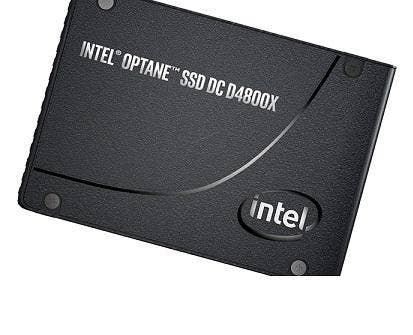Intel Aims To Change Server-Based Storage, Memory Economics With New Optane Tech

Intel is making a greater push into the data center storage business with new storage and memory devices the company claims will accelerate modern workloads, including artificial intelligence.
Intel Tuesday introduced two new storage products, a dual-port version of its Optane storage module and a new member of its “ruler” family of high-density flash storage modules complying with the new industry EDSFF, or Enterprise & Data Center SSD Form Factor, format.
The vendor complemented those with the introduction of its new Optane Data Center Persistent Memory, a new module that provides performance approaching that of DRAM but that will not lose memory if the module loses power.
[Related: Xeon Scalable, Optane Lead Intel's Big Data Center Rollout]
The new storage and memory offerings are targeted at the same mission-critical applications that Intel is targeting with its new second-generation Xeon Scalable processor, said Navin Shenoy, executive vice president and general manager of Intel's Data Center Group.
"This is a great example of something that we are uniquely positioned to deliver," Shenoy said. "This required us to develop a new Optane media on the memory side. It required us to reinvent the memory controller in the CPU. It required us to develop new firmware to have these pieces work together. And we had to invest heavily in bringing together software and solution optimization from the entire ecosystem."
The first new storage product, the Optane Data Center SSD, is a dual-port version of the Optane storage module already in the market, Shenoy said. The Optane DC SSD is aimed at mission-critical applications.
The second is a new version of Intel's “ruler” series of flash storage drives. The new ruler features QLC NAND flash memory, and brings a petabyte of capacity into a very small form factor, he said. Intel also introduced its Optane Data Center Persistent Memory to go with Intel's newly-released second-generation Xeon Scalable processor.
In its largest configuration, the Optane DC Persistent Memory module contains 512 GBs of memory, which Shenoy called the largest-capacity memory module in the world. "We expect server system capacity to scale to 4.5 Tbytes per socket, or 36 TBs in an 8-socket system. … And this larger capacity allows us to unlock performance to reduce those bottlenecks."
The Optane DC Persistent Memory module, together with the new second-generation Xeon scalable processor, is aimed at disrupting memory economics, said Jennifer Huffstetler, vice president and general manager of Intel's data center product management team.
Performance-wise, the Optane DC Persistent Memory modules sit between high-performance SSDs and extremely low-latency DRAM, but without the DRAM disadvantage of losing memory if the power is lost, Huffstetler told CRN.
"We see customers struggle to scale because DRAM is so expensive," she said. "The first large use case for it is to provide a big and affordable way to deliver a greater than 1.2-X performance increase per dollar of TCO (total cost of ownership). The second use case is infrastructure consolidation. With large, affordable memory, we're seeing customers consolidate workloads, getting more virtual machines per server and using fewer servers."
Alper Ilkbahar, vice president and general manager for Intel's data center memory and storage solutions, told CRN that the Optane DC Persistent Memory modules provide performance about 1,000 times that of the NAND memory used to make SSDs.
The Optane DC Persistent Memory comes with two modes of operation, Ilkbahar said.
The first is memory mode, which when paired with the new Cascade Lake second-generation Xeon Scalable processors, allows it to use the server's DRAM as a high-speed cache which automatically moves data not immediately needed to the Optane modules.
"The software is unaware of what's going on," he said. The processor seamlessly manages the memory tiers. There's no changes needed to the applications."
The second is the App Direct mode in which software applications that have been optimized for Optane DC Persistent Memory can automatically tier the data between the Optane modules and DRAM, Ilkbahar said.
"The software decides which data goes where," he said. "This offers full performance. The only drawback is that the software applications must be optimized."
Intel is working with ISVs whose applications work at the data access layer to make the optimization possible, Ilkbahar said. The first to make the change are operating system and providers and developers of hypervisors including VMware, Microsoft, and KVM, he said.
Other applications which take advantage of in-server memory, including SAP HANA, Redis, Arrow Spike, Apache Spark, and NetApp's new MAX Data have already done so as well, he said.
The Cascade Lake processors are required to use the Optane DC Persistent Memory, Ilkbahar said. Each processor has six channel, each of which has two slots. Only one of the two slots can be used for the Optane module, while the other is used for DDR4 DRAM, he said.
The Optane DC Persistent Memory modules are available in 128-GB, 256-GB, and 512-GB versions, he said.
The new Optane modules are a real game changer for server clients, said Jim Sangster, senior director of product marketing for Supermicro, the San Jose, Calif.-based custom system builder.
"They provide more memory, and cheaper memory because of their lower price when compared to DRAM," Sangster told CRN. "So for the same price as existing servers, customers can get the higher performance at a lower cost."
While the Optane DC Persistent Memory modules in their App Direct form provide the highest performance, it is the memory mode where they will shine, Sangster said.
"The really good news about the memory mode is that the applications don't have to change," he said. "Optane just works like big memory."